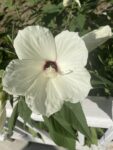
Native Gardening with Jimmy: Designing for endless blooms
By JIMMY ROGERS

Credit: Jimmy Rogers
Flowers tell us what time it is. When you walk by the same patch of ground month after month, and one day see a new bloom, it makes a mark in your primeval calendar. The next year, when you see that bloom again, you’ll be reminded that it’s time to put away your winter clothes or that the Independence Day parade is only a few weeks away.
Gardeners describe this predictable pattern as a plant’s bloom time. It’s a subset of phenology, the study of when things happen in nature. Plants repeat specific processes each year: emerging, developing, flowering, fruiting and declining. Drought years, like the one we’ve had in 2024, can play havoc with the phenology of a plant — and especially its bloom time, as some plants may be forced into a period of dormancy to conserve water. But we can largely trust that a particular plant in a particular location will bloom reliably at the same time each year.
Bloom time for aesthetics
Gardeners often think about bloom time to ensure their beds have attractive flowers throughout the growing season. Conventional gardens use long-blooming, exotic cultivars to add color to an otherwise evergreen space. Plants that have been repeatedly selected by growers for larger flowers and longer bloom time have been shown to produce less nectar and pollen, even to the point of plant sterility. This is often the case with annuals, which ornamental gardeners may dig up and replace as frequently as twice a year — an expensive practice.
Planning for full bloom time in a native garden is both challenging and rewarding. Native plants tend to bloom for shorter periods than exotic cultivars, so your garden will need many species per square foot. And by planting native species, you can plan for blooms as early as March and as late as November instead of focusing only on a few warmer months. What’s the reward for all this work? If you design for full bloom time, you’ll have an extremely diverse garden with new flowers opening at least every three to four weeks. Doesn’t that sound like garden tour material?
Bloom time for wildlife
So far I’ve spoken exclusively about human interests, but for every flower, there is at least one animal that evolved to depend on it. When hibiscus flowers bloom, hibiscus bees (Ptilothrix bombiformis) find them the very same day. I see this in my yard every year, even in my first year growing our native swamp rose mallow (Hibiscus moscheutos). These bees awake for the season just in time to feed exclusively on hibiscus species, mate within the flowers and then build underground nests to lay the next generation. So much depends on a flower opening on time.
As you increase the diversity of species in your garden, your bloom coverage will be greater, and you’ll support a greater number of specialist pollinators, along with generalist pollinators such as bumblebees and butterflies. Gardeners can particularly help early- and late-season bees by growing plants that bloom in March, April, October and November, when flowers are scarcer. You will immediately start to notice these pollinators in your garden.
Designing for bloom time
Whether you have an existing garden or are planning a new bed, you can use a spreadsheet to track bloom times— I list my species in one column and the starting bloom time in another. This information can be found with a quick search online, or you can check bloom times at nativeplantcenter.net. Once you’ve populated your own sheet, sort the months in chronological order and see if there are any gaps throughout the growing season. If, for instance, you only have April and June blooms, search for a May blooming plant you can add, like beardtongue (Penstemon digitalis).
Also look at the edges of your bloom time. If you’ve got an April bloomer, that’s great. Can you find something for March, too? For the fall, consider planting several late bloomers together, such as goldenrods (yellow) and asters (white, blue or purple), for a final burst of life to celebrate a successful year of gardening.
Once your garden, as a whole, has good bloom coverage, think about specific beds or zones. The goldenrods and asters I just mentioned will be fabulous in September, but make sure to plant early-blooming companions alongside, to ensure the area has a succession of blooms throughout the year.
If your garden is in shade, you may find yourself scratching your head, as shady natives tend to bloom early in the year. I recommend focusing on diversity and texture as opposed to bloom time in shade gardens. Ferns, for instance, do not have traditional blooms, but their emergence and development at different times can add interest to your garden. Try to find at least one plant that blooms in summer, such as orange jewelweed (Impatiens capensis), and then another in fall, such as white wood aster (Eurybia divaricata).
And you can set the bar low to start. If you add just one or two months of new blooms to your garden, it will support way more wildlife. If, over time, you’re able to cover most of the growing season, your garden will look more attractive and function better than most of those planted by professionals.



